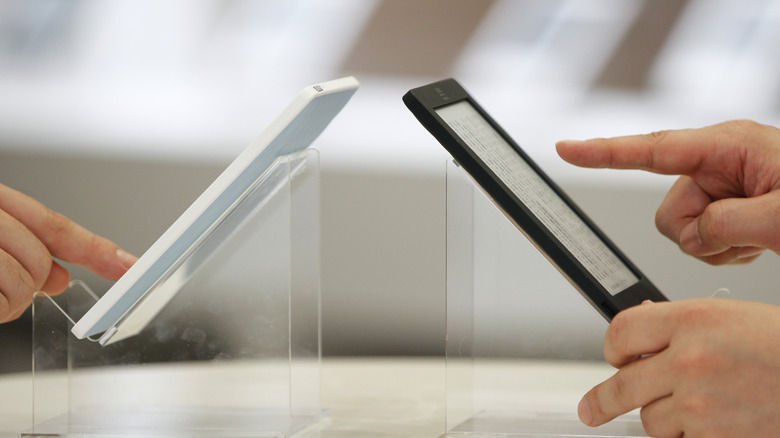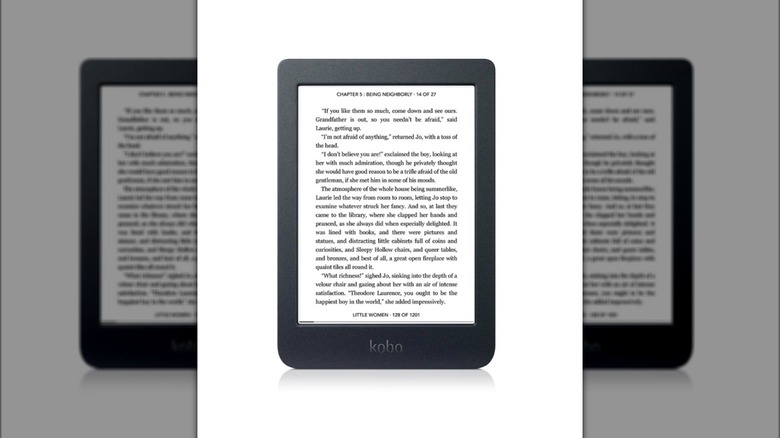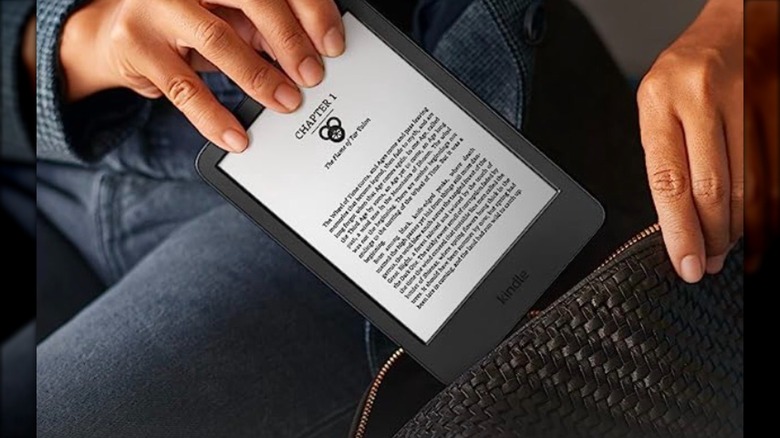How Does The Kobo E-Reader Stack Up Against The Kindle?
We may receive a commission on purchases made from links.
While those with more traditional or romantic tendencies may have had their reservations when e-readers entered the scene and slowly crept up on the ritual of holding a physical book, it can't be denied that they've also garnered a lot of praise — as well as popularity. Storing your books in one easy-to-access, portable spot comes with many perks. And if you want to start reading more, investing in an e-reader is a wise move. But as the e-reader market has grown into a sea of sometimes overwhelming options, how do we know which one will be the best investment?
Chances are you know a thing or two about the Kindle, particularly if you're already using the Amazon ecosystem, but what about its rival? The second-biggest e-reader and e-book retailer is the Canadian-based Kobo, which is owned by the Japanese company Ratuken. Does it stack up to the mighty Amazon Kindle? The two look nearly identical at first glance, but users seem to have mixed opinions when it comes to which e-reader takes the throne. In order to investigate for ourselves, we took a look at style, pricing, storage, storefronts, subscriptions, and more. In many of these areas, Kindle does seem to have a slight upper hand, but Kobo does still offer a very similar product for those who want to discourage Amazon from monopolizing the market.
A brief overview of Kobo and Kindle
Amazon offers seven e-reader Kindle types — two of which are models for kids — ranging from $99 to $339.99 at the time of writing. The standard Amazon Kindle, coming in at $99, is labeled as its bestseller and was also chosen by Wirecutter of The New York Times as its top pick and "best e-reader for most people." Comparably, Kobo offers six e-readers, ranging from $109.99 to $399.99, in addition to several refurbished options. Kobo's basic e-reader, the Kobo Nia, retails for $109.99 and has a 6-inch screen, just like Amazon's Kindle.
Overall, Kindle offers more options when it comes to device range and tier (not including Kobo's refurbished models). And Kindle's range includes e-readers designed for children, but that isn't to say a youngster couldn't operate and enjoy a standard edition Kobo e-reader. While both will serve their purpose in sweeping you away into the world of the written word, there are some other minor yet noteworthy differences to keep in mind when selecting your next e-reader.
The basic Kindle has a higher resolution
As mentioned earlier, the Kindle and the Kobo could easily be mistaken for one another at a quick glance. They share the same slim appearance in black with a white screen. Both the Kobo and Kindle models are front-lit, meaning you won't experience the bright light in your eyes as you do with a phone, making the experience closer to that of reading an actual book. Plus, both the Kindle and the Kobo are glare-free with adjustable light and dark settings.
In terms of screen resolution, the standard Kindle offers "300 PPI high-resolution display for sharp text and images," according to Amazon, while the standard Kobo offers a slightly lower resolution at 212 PPI. However, if you take a step up and opt for the Kobo Clara 2E at $139.99, it offers the same 300 PPI resolution as the standard Kindle. If you tend to read in the bath or poolside, choosing a waterproof device is likely one of your determining factors. The basic readers from both Kindle and Kobo aren't waterproof; however, the Kindle Paperwhite Signature Edition at $189.99 and the Kobo Clara 2E are both waterproof.
Storage is similar, but not all Kobo models have bluetooth
The number of books your e-reader can hold might be at the top of your priority list if you're a book aficionado and know you'll want to stuff your Kindle or Kobo. When it comes to storage, the question of which model you choose is more important than which brand you buy from. Both Kindle and Kobo offer a range of devices with differing storage abilities, all the way from 8GB to 64GB. Devices from both Kindle and Kobo can store books externally in the Cloud, but it's perfectly logical to want enough room in your internal storage for your library. The average e-book is only 2.6MB, so even the standard e-reader with 8GB of storage will hold enough books for most readers (via Elite Authors).
If you're more keen on listening to audiobooks, then there are a few features you'll want to scope out on both the Kindle and the Kobo. Essentially, Bluetooth is key to listen to your audiobooks from your e-reader. And all new devices from both brands do have Bluetooth connectivity — except the Kobo Nia. If you already have an Amazon Audible account subscription, then the Kindle might make more sense for you.
Kindle has a larger library, but it's easier to access other content through Kobo
Whether you use Kindle or Kobo, both allow e-books that don't come from their own libraries. Though traditionally users have been more impressed with Kobo due to the ease of downloading outside e-books onto these devices, Amazon seems to have caught up with the competition to an extent. Taking e-books from Amazon still seems to be the primary method of accessing content, but now there are other options that allow users to access e-books from elsewhere, including Amazon's Send to Kindle service and using free software to modify the format of your files. Accessing this content may require slightly more time and effort on Kindle, but it is possible.
But if you're big on audiobooks, it's worth noting that there is a limitation when it comes to Kobo. You'll only be able to listen to the audiobooks available in the Kobo library. In terms of subscription cost, Kindle Unlimited runs at $11.99 per month, for which you have access to more than 4 million e-books. Meanwhile, Kobo Plus comes in at $7.99 monthly, and $9.99 for Kobo Read & Listen, and will give you access to 1.3 million e-books and approximately 10,000 audiobooks.
Kindle may have a step up, but Kobo still gets the job done
All in all, the Kobo e-reader does seem to stack up against the Kindle in many regards. Amazon's Kindle may have a slightly longer stride in terms of price point, storage, and resolution, but easier access to a wider range of reading material might just be the kicker for some buyers, leading them to turn to Kobo. Kobo may also be the best option for those simply wanting to break free from an ever-growing and powerful super company, like Amazon. "Don't let Amazon rule the world. I like the idea of buying from Kobo as much as possible. I think there needs to be competition to the near Amazon monopoly," one user commented on Reddit.
Regardless of whether you choose to give the Kobo a whirl or stick with your Kindle, the number of stories and titles readily available to us at a touch thanks to e-readers is something book lovers of the past would have likely cherished, and having this access through any device is definitely something to being grateful for. As one Kindle reviewer put it on Amazon, "The Kindle is a marvelous invention that got me reading again and reading three to four times as much as I ever did with paper books."





